A Study of Diabetes and Risk Factors in Hispanic American Youth
VerifiedAdded on 2023/04/20
|9
|1471
|338
Report
AI Summary
This report investigates the prevalence and risk factors associated with diabetes in Hispanic American youth. The study focuses on a population in Miami, Florida, and employs a case-control study design to examine the relationship between family history and diabetes diagnosis. Logistic regression analysis is used to assess the significance of race and family history as predictors of diabetes. The research utilizes questionnaires to gather data on diabetes diagnosis, race, and family history. The findings aim to contribute to a better understanding of diabetes incidence and prevalence within the Hispanic community, potentially leading to more targeted interventions. The report includes an introduction, methodology, statistical tests, and a conclusion summarizing the key insights and implications of the research. It also references relevant literature in the field. This is a valuable resource for students on Desklib.

DIABETICS IN HISPANIC AMERICAN YOUTH
Paraphrase This Document
Need a fresh take? Get an instant paraphrase of this document with our AI Paraphraser

DIABETICS IN HISPANIC AMERICAN YOUTH
CONTENTS
INTRODUCTION.......................................................................................................................................3
POPULATION AND SAMPLE SIZE.........................................................................................................3
VARIABLES..............................................................................................................................................4
HYPOTHESIS TESTING...........................................................................................................................5
RESEARCH INSTRUMENTS...................................................................................................................5
STATISTICAL TESTS (BIVARIATE)......................................................................................................6
STATISTICAL TESTS (MULTIVARIATE METHODS)..........................................................................7
CONCLUSION...........................................................................................................................................7
REFERENCES............................................................................................................................................8
2
CONTENTS
INTRODUCTION.......................................................................................................................................3
POPULATION AND SAMPLE SIZE.........................................................................................................3
VARIABLES..............................................................................................................................................4
HYPOTHESIS TESTING...........................................................................................................................5
RESEARCH INSTRUMENTS...................................................................................................................5
STATISTICAL TESTS (BIVARIATE)......................................................................................................6
STATISTICAL TESTS (MULTIVARIATE METHODS)..........................................................................7
CONCLUSION...........................................................................................................................................7
REFERENCES............................................................................................................................................8
2
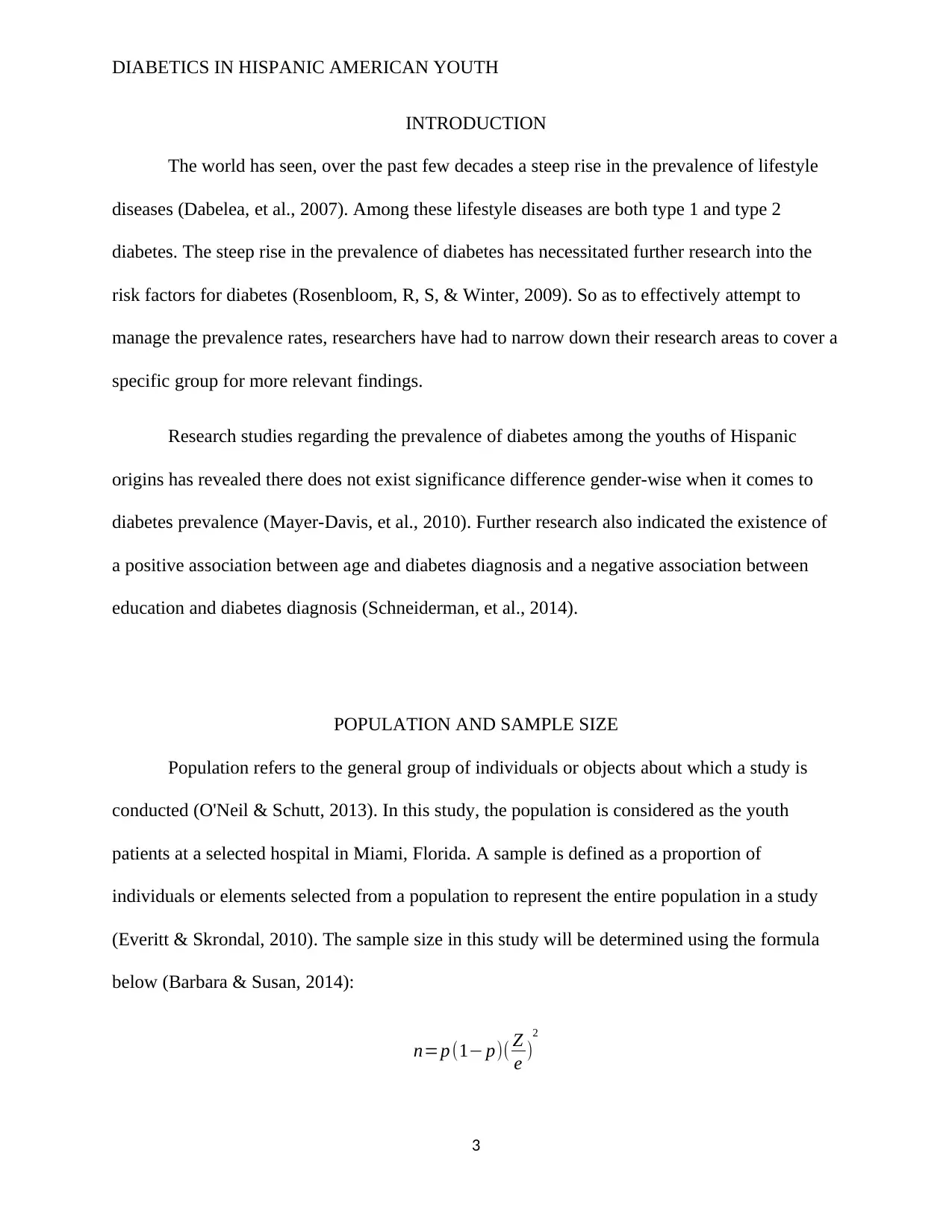
DIABETICS IN HISPANIC AMERICAN YOUTH
INTRODUCTION
The world has seen, over the past few decades a steep rise in the prevalence of lifestyle
diseases (Dabelea, et al., 2007). Among these lifestyle diseases are both type 1 and type 2
diabetes. The steep rise in the prevalence of diabetes has necessitated further research into the
risk factors for diabetes (Rosenbloom, R, S, & Winter, 2009). So as to effectively attempt to
manage the prevalence rates, researchers have had to narrow down their research areas to cover a
specific group for more relevant findings.
Research studies regarding the prevalence of diabetes among the youths of Hispanic
origins has revealed there does not exist significance difference gender-wise when it comes to
diabetes prevalence (Mayer-Davis, et al., 2010). Further research also indicated the existence of
a positive association between age and diabetes diagnosis and a negative association between
education and diabetes diagnosis (Schneiderman, et al., 2014).
POPULATION AND SAMPLE SIZE
Population refers to the general group of individuals or objects about which a study is
conducted (O'Neil & Schutt, 2013). In this study, the population is considered as the youth
patients at a selected hospital in Miami, Florida. A sample is defined as a proportion of
individuals or elements selected from a population to represent the entire population in a study
(Everitt & Skrondal, 2010). The sample size in this study will be determined using the formula
below (Barbara & Susan, 2014):
n=p (1− p)( Z
e )
2
3
INTRODUCTION
The world has seen, over the past few decades a steep rise in the prevalence of lifestyle
diseases (Dabelea, et al., 2007). Among these lifestyle diseases are both type 1 and type 2
diabetes. The steep rise in the prevalence of diabetes has necessitated further research into the
risk factors for diabetes (Rosenbloom, R, S, & Winter, 2009). So as to effectively attempt to
manage the prevalence rates, researchers have had to narrow down their research areas to cover a
specific group for more relevant findings.
Research studies regarding the prevalence of diabetes among the youths of Hispanic
origins has revealed there does not exist significance difference gender-wise when it comes to
diabetes prevalence (Mayer-Davis, et al., 2010). Further research also indicated the existence of
a positive association between age and diabetes diagnosis and a negative association between
education and diabetes diagnosis (Schneiderman, et al., 2014).
POPULATION AND SAMPLE SIZE
Population refers to the general group of individuals or objects about which a study is
conducted (O'Neil & Schutt, 2013). In this study, the population is considered as the youth
patients at a selected hospital in Miami, Florida. A sample is defined as a proportion of
individuals or elements selected from a population to represent the entire population in a study
(Everitt & Skrondal, 2010). The sample size in this study will be determined using the formula
below (Barbara & Susan, 2014):
n=p (1− p)( Z
e )
2
3
⊘ This is a preview!⊘
Do you want full access?
Subscribe today to unlock all pages.

Trusted by 1+ million students worldwide
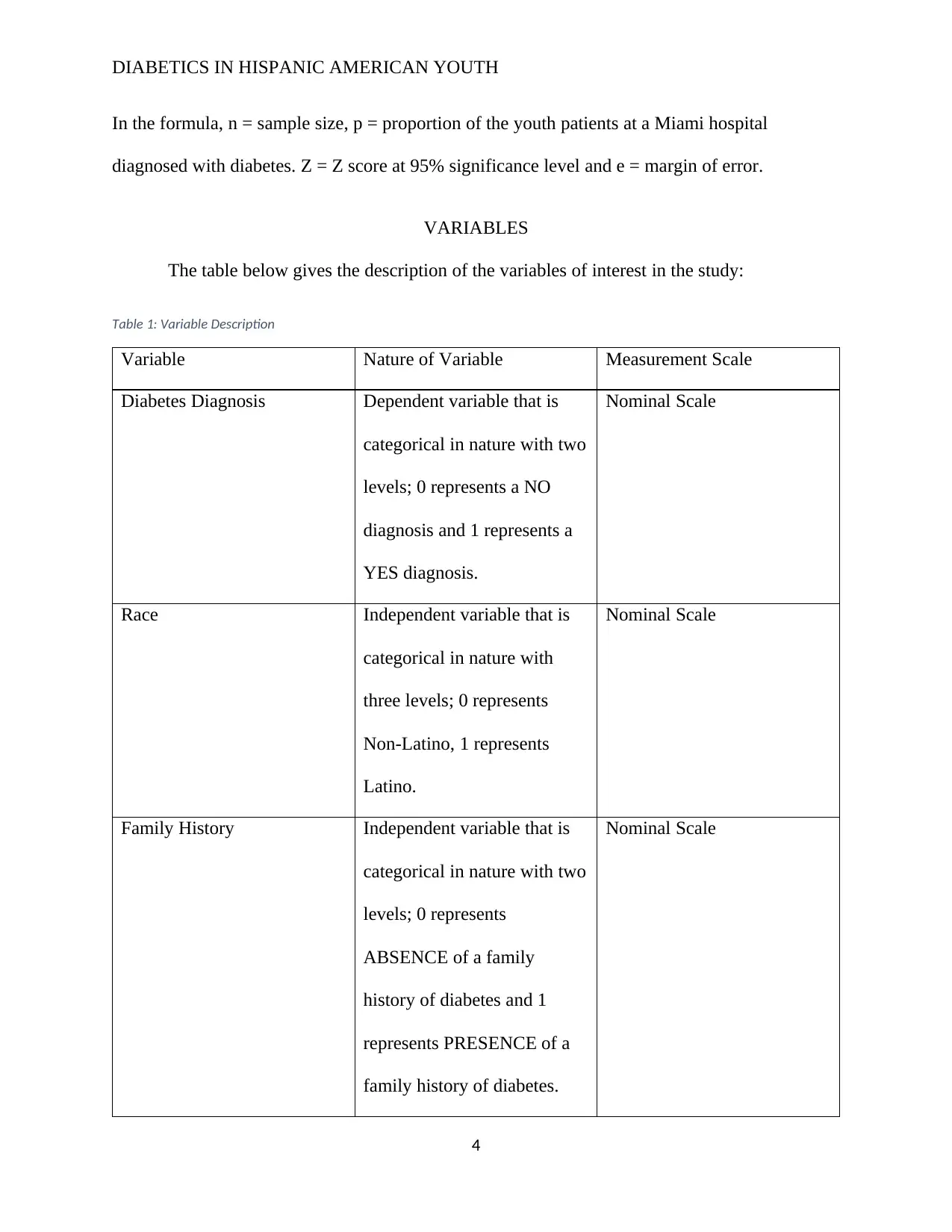
DIABETICS IN HISPANIC AMERICAN YOUTH
In the formula, n = sample size, p = proportion of the youth patients at a Miami hospital
diagnosed with diabetes. Z = Z score at 95% significance level and e = margin of error.
VARIABLES
The table below gives the description of the variables of interest in the study:
Table 1: Variable Description
Variable Nature of Variable Measurement Scale
Diabetes Diagnosis Dependent variable that is
categorical in nature with two
levels; 0 represents a NO
diagnosis and 1 represents a
YES diagnosis.
Nominal Scale
Race Independent variable that is
categorical in nature with
three levels; 0 represents
Non-Latino, 1 represents
Latino.
Nominal Scale
Family History Independent variable that is
categorical in nature with two
levels; 0 represents
ABSENCE of a family
history of diabetes and 1
represents PRESENCE of a
family history of diabetes.
Nominal Scale
4
In the formula, n = sample size, p = proportion of the youth patients at a Miami hospital
diagnosed with diabetes. Z = Z score at 95% significance level and e = margin of error.
VARIABLES
The table below gives the description of the variables of interest in the study:
Table 1: Variable Description
Variable Nature of Variable Measurement Scale
Diabetes Diagnosis Dependent variable that is
categorical in nature with two
levels; 0 represents a NO
diagnosis and 1 represents a
YES diagnosis.
Nominal Scale
Race Independent variable that is
categorical in nature with
three levels; 0 represents
Non-Latino, 1 represents
Latino.
Nominal Scale
Family History Independent variable that is
categorical in nature with two
levels; 0 represents
ABSENCE of a family
history of diabetes and 1
represents PRESENCE of a
family history of diabetes.
Nominal Scale
4
Paraphrase This Document
Need a fresh take? Get an instant paraphrase of this document with our AI Paraphraser
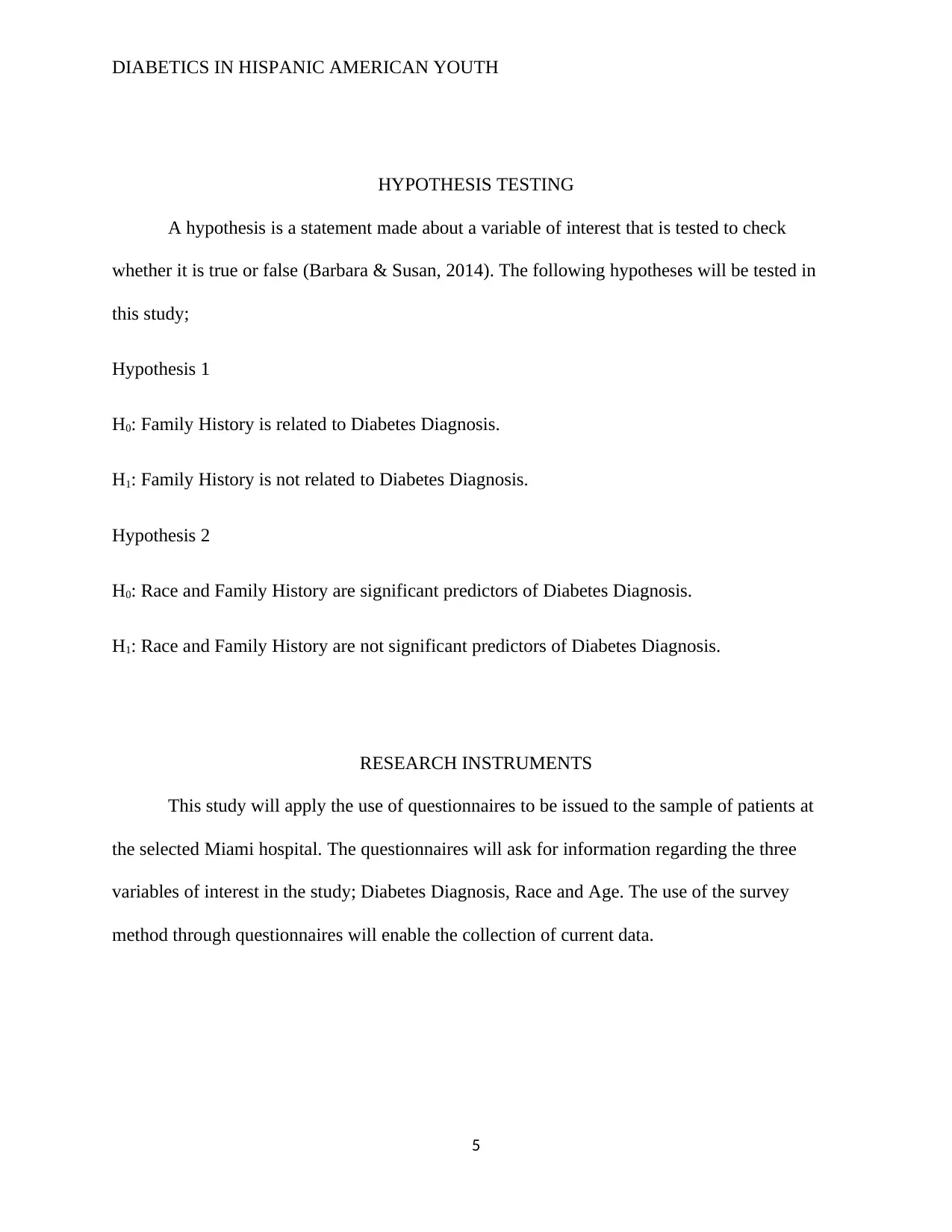
DIABETICS IN HISPANIC AMERICAN YOUTH
HYPOTHESIS TESTING
A hypothesis is a statement made about a variable of interest that is tested to check
whether it is true or false (Barbara & Susan, 2014). The following hypotheses will be tested in
this study;
Hypothesis 1
H0: Family History is related to Diabetes Diagnosis.
H1: Family History is not related to Diabetes Diagnosis.
Hypothesis 2
H0: Race and Family History are significant predictors of Diabetes Diagnosis.
H1: Race and Family History are not significant predictors of Diabetes Diagnosis.
RESEARCH INSTRUMENTS
This study will apply the use of questionnaires to be issued to the sample of patients at
the selected Miami hospital. The questionnaires will ask for information regarding the three
variables of interest in the study; Diabetes Diagnosis, Race and Age. The use of the survey
method through questionnaires will enable the collection of current data.
5
HYPOTHESIS TESTING
A hypothesis is a statement made about a variable of interest that is tested to check
whether it is true or false (Barbara & Susan, 2014). The following hypotheses will be tested in
this study;
Hypothesis 1
H0: Family History is related to Diabetes Diagnosis.
H1: Family History is not related to Diabetes Diagnosis.
Hypothesis 2
H0: Race and Family History are significant predictors of Diabetes Diagnosis.
H1: Race and Family History are not significant predictors of Diabetes Diagnosis.
RESEARCH INSTRUMENTS
This study will apply the use of questionnaires to be issued to the sample of patients at
the selected Miami hospital. The questionnaires will ask for information regarding the three
variables of interest in the study; Diabetes Diagnosis, Race and Age. The use of the survey
method through questionnaires will enable the collection of current data.
5
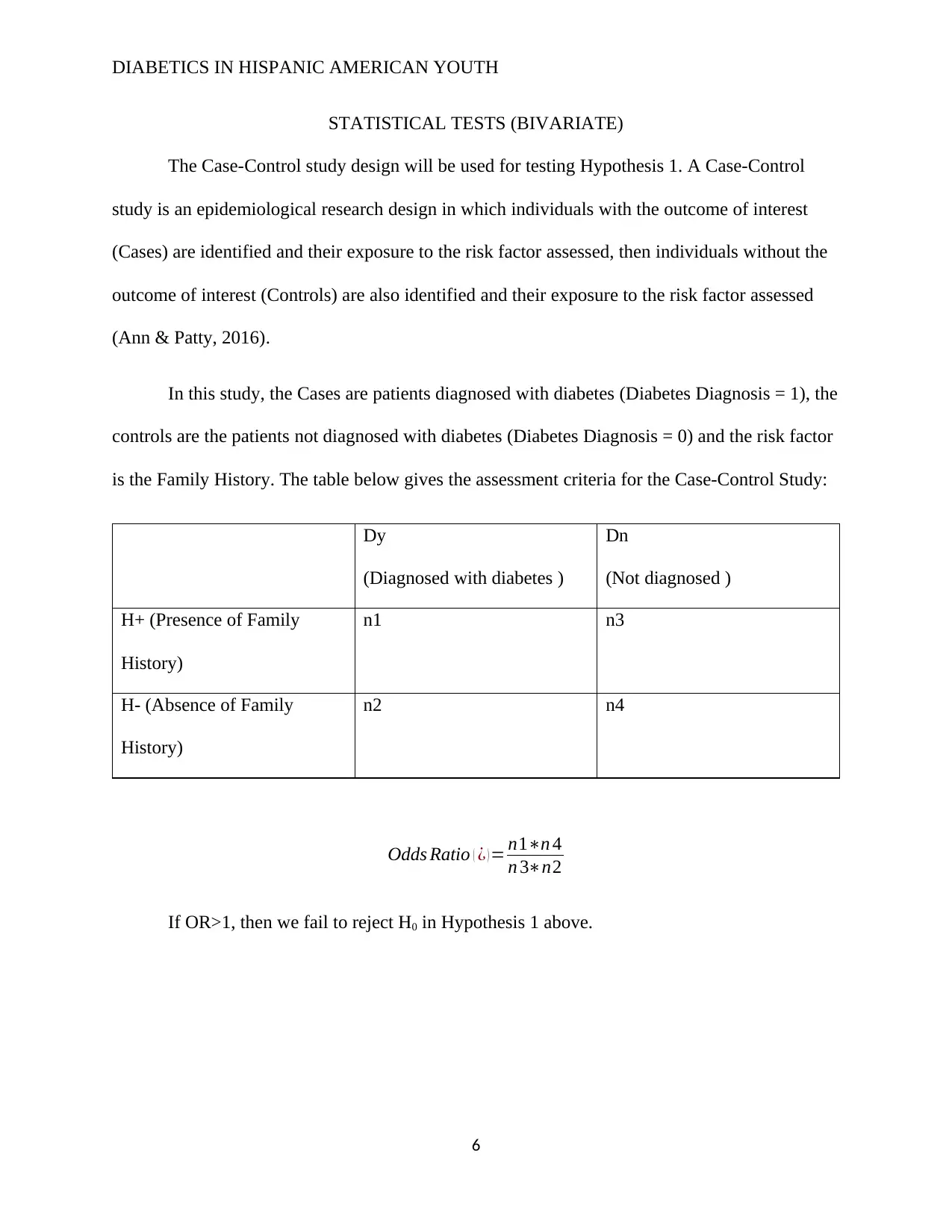
DIABETICS IN HISPANIC AMERICAN YOUTH
STATISTICAL TESTS (BIVARIATE)
The Case-Control study design will be used for testing Hypothesis 1. A Case-Control
study is an epidemiological research design in which individuals with the outcome of interest
(Cases) are identified and their exposure to the risk factor assessed, then individuals without the
outcome of interest (Controls) are also identified and their exposure to the risk factor assessed
(Ann & Patty, 2016).
In this study, the Cases are patients diagnosed with diabetes (Diabetes Diagnosis = 1), the
controls are the patients not diagnosed with diabetes (Diabetes Diagnosis = 0) and the risk factor
is the Family History. The table below gives the assessment criteria for the Case-Control Study:
Dy
(Diagnosed with diabetes )
Dn
(Not diagnosed )
H+ (Presence of Family
History)
n1 n3
H- (Absence of Family
History)
n2 n4
Odds Ratio ( ¿ ) = n1∗n 4
n 3∗n2
If OR>1, then we fail to reject H0 in Hypothesis 1 above.
6
STATISTICAL TESTS (BIVARIATE)
The Case-Control study design will be used for testing Hypothesis 1. A Case-Control
study is an epidemiological research design in which individuals with the outcome of interest
(Cases) are identified and their exposure to the risk factor assessed, then individuals without the
outcome of interest (Controls) are also identified and their exposure to the risk factor assessed
(Ann & Patty, 2016).
In this study, the Cases are patients diagnosed with diabetes (Diabetes Diagnosis = 1), the
controls are the patients not diagnosed with diabetes (Diabetes Diagnosis = 0) and the risk factor
is the Family History. The table below gives the assessment criteria for the Case-Control Study:
Dy
(Diagnosed with diabetes )
Dn
(Not diagnosed )
H+ (Presence of Family
History)
n1 n3
H- (Absence of Family
History)
n2 n4
Odds Ratio ( ¿ ) = n1∗n 4
n 3∗n2
If OR>1, then we fail to reject H0 in Hypothesis 1 above.
6
⊘ This is a preview!⊘
Do you want full access?
Subscribe today to unlock all pages.

Trusted by 1+ million students worldwide
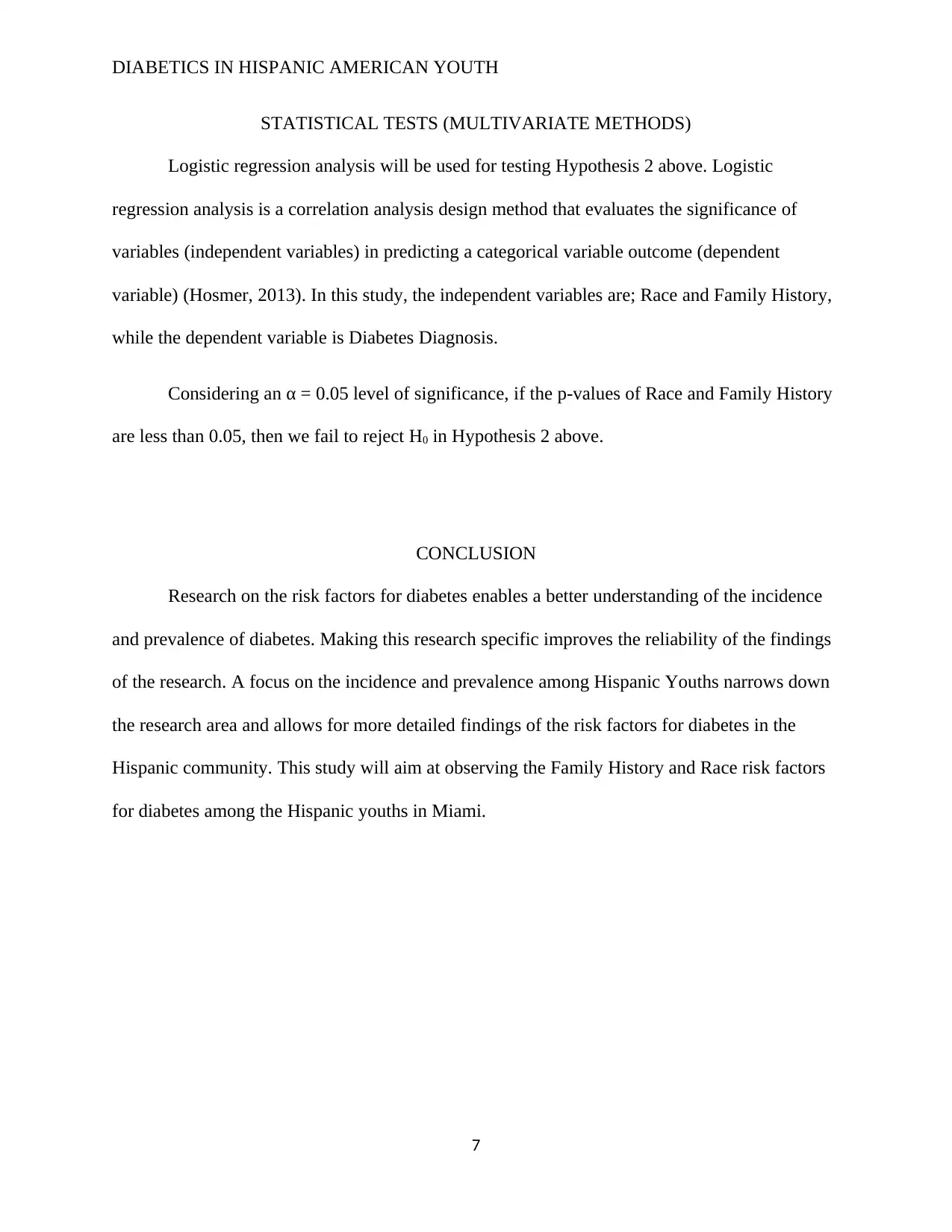
DIABETICS IN HISPANIC AMERICAN YOUTH
STATISTICAL TESTS (MULTIVARIATE METHODS)
Logistic regression analysis will be used for testing Hypothesis 2 above. Logistic
regression analysis is a correlation analysis design method that evaluates the significance of
variables (independent variables) in predicting a categorical variable outcome (dependent
variable) (Hosmer, 2013). In this study, the independent variables are; Race and Family History,
while the dependent variable is Diabetes Diagnosis.
Considering an α = 0.05 level of significance, if the p-values of Race and Family History
are less than 0.05, then we fail to reject H0 in Hypothesis 2 above.
CONCLUSION
Research on the risk factors for diabetes enables a better understanding of the incidence
and prevalence of diabetes. Making this research specific improves the reliability of the findings
of the research. A focus on the incidence and prevalence among Hispanic Youths narrows down
the research area and allows for more detailed findings of the risk factors for diabetes in the
Hispanic community. This study will aim at observing the Family History and Race risk factors
for diabetes among the Hispanic youths in Miami.
7
STATISTICAL TESTS (MULTIVARIATE METHODS)
Logistic regression analysis will be used for testing Hypothesis 2 above. Logistic
regression analysis is a correlation analysis design method that evaluates the significance of
variables (independent variables) in predicting a categorical variable outcome (dependent
variable) (Hosmer, 2013). In this study, the independent variables are; Race and Family History,
while the dependent variable is Diabetes Diagnosis.
Considering an α = 0.05 level of significance, if the p-values of Race and Family History
are less than 0.05, then we fail to reject H0 in Hypothesis 2 above.
CONCLUSION
Research on the risk factors for diabetes enables a better understanding of the incidence
and prevalence of diabetes. Making this research specific improves the reliability of the findings
of the research. A focus on the incidence and prevalence among Hispanic Youths narrows down
the research area and allows for more detailed findings of the risk factors for diabetes in the
Hispanic community. This study will aim at observing the Family History and Race risk factors
for diabetes among the Hispanic youths in Miami.
7
Paraphrase This Document
Need a fresh take? Get an instant paraphrase of this document with our AI Paraphraser

DIABETICS IN HISPANIC AMERICAN YOUTH
REFERENCES
Ann, C. L., & Patty, V. A. (2016). Population-Based Nursing [Electronic Resource]: Cocepts
and Competencies for Advanced Practice 2nd Edition. New York: Springer Publishing
Company.
Barbara, I., & Susan, D. (2014). Introductory Statistics (1st ed.). New York: OpenStax CNX.
Dabelea, D., Bell, R. A., D'agostino, ,. J., Imperatore, G., Johansen, J. M., Linder, B., & Pettitt,
D. J. (2007). Incidence of Diabetes in Youths in the United States. Jama, 2716-2724.
Everitt, B. S., & Skrondal, A. (2010). Cambridge Dictionary of Statistics (4th ed.). London:
Cambridge University Press.
Hamra, G. B., Laden, F., Cohen, A. J., Raaschou-Nielsen, O., Brauer, M., & Loomis, D. (2015).
Lung Cancer and Exposure to Nitrogen Dioxide and Traffic: A Systematic Review and
Meta-Analysis. Environmental Health Perspective, 123(11), 1107-1112.
Hosmer, D. (2013). Applied Logistic Regression (1 ed.). Hoboken, New Jersey: Wiley.
Mayer-Davis, E. J., Reynolds, K., Beyer, J., Pettitt, D. J., D'agostino, R. B., & Hamman, R. F.
(2010). Diabetes in Hispanic American Youth: Prevelance, Incidence, Demographics and
Clinical Characteristics: The Search for Diabetes in Youth Study. Diabetes Care, 123-
132.
O'Neil, C., & Schutt, R. (2013). Doing Data Science (3rd ed.). London: O'Reily.
Rosenbloom, A. L., R, J. J., S, Y. R., & Winter, W. E. (2009). Emerging Epidemic of Type 2
Diabetes in Youth. Diabetes Care, 345-354.
8
REFERENCES
Ann, C. L., & Patty, V. A. (2016). Population-Based Nursing [Electronic Resource]: Cocepts
and Competencies for Advanced Practice 2nd Edition. New York: Springer Publishing
Company.
Barbara, I., & Susan, D. (2014). Introductory Statistics (1st ed.). New York: OpenStax CNX.
Dabelea, D., Bell, R. A., D'agostino, ,. J., Imperatore, G., Johansen, J. M., Linder, B., & Pettitt,
D. J. (2007). Incidence of Diabetes in Youths in the United States. Jama, 2716-2724.
Everitt, B. S., & Skrondal, A. (2010). Cambridge Dictionary of Statistics (4th ed.). London:
Cambridge University Press.
Hamra, G. B., Laden, F., Cohen, A. J., Raaschou-Nielsen, O., Brauer, M., & Loomis, D. (2015).
Lung Cancer and Exposure to Nitrogen Dioxide and Traffic: A Systematic Review and
Meta-Analysis. Environmental Health Perspective, 123(11), 1107-1112.
Hosmer, D. (2013). Applied Logistic Regression (1 ed.). Hoboken, New Jersey: Wiley.
Mayer-Davis, E. J., Reynolds, K., Beyer, J., Pettitt, D. J., D'agostino, R. B., & Hamman, R. F.
(2010). Diabetes in Hispanic American Youth: Prevelance, Incidence, Demographics and
Clinical Characteristics: The Search for Diabetes in Youth Study. Diabetes Care, 123-
132.
O'Neil, C., & Schutt, R. (2013). Doing Data Science (3rd ed.). London: O'Reily.
Rosenbloom, A. L., R, J. J., S, Y. R., & Winter, W. E. (2009). Emerging Epidemic of Type 2
Diabetes in Youth. Diabetes Care, 345-354.
8

DIABETICS IN HISPANIC AMERICAN YOUTH
Schneiderman, N., Llabre, M., Cowie, C. C., Barnhat, J., Carnethon, M., Gallo, L. C., & Teng,
Y. (2014). Prevalence of Diabetes among Hispanic/Latinos from Diverse Backgrounds:
the Hispanic community health study/study of Latinos. Diabetes Care, 2233-2239.
9
Schneiderman, N., Llabre, M., Cowie, C. C., Barnhat, J., Carnethon, M., Gallo, L. C., & Teng,
Y. (2014). Prevalence of Diabetes among Hispanic/Latinos from Diverse Backgrounds:
the Hispanic community health study/study of Latinos. Diabetes Care, 2233-2239.
9
⊘ This is a preview!⊘
Do you want full access?
Subscribe today to unlock all pages.

Trusted by 1+ million students worldwide
1 out of 9
Your All-in-One AI-Powered Toolkit for Academic Success.
+13062052269
info@desklib.com
Available 24*7 on WhatsApp / Email
![[object Object]](/_next/static/media/star-bottom.7253800d.svg)
Unlock your academic potential
Copyright © 2020–2026 A2Z Services. All Rights Reserved. Developed and managed by ZUCOL.

